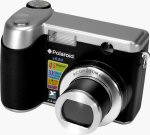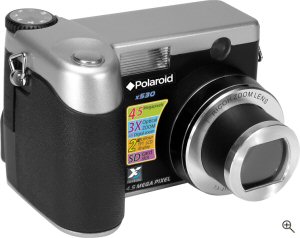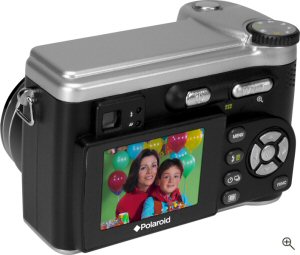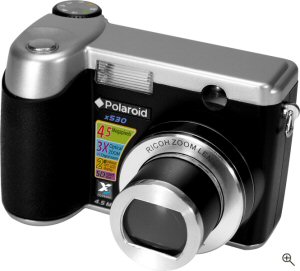 New Foveon X3-based digicam announced at PMA
New Foveon X3-based digicam announced at PMA
By
Mike Tomkins
(Monday, February 9, 2004 - 13:42 EST)
Foveon Inc. has today pushed forward an announcement originally scheduled for Wednesday at the Spring 2004 Photo Marketing Association show in Las Vegas.
The company has now lined up its first customer to offer a consumer point-and-shoot digital camera - a pretty significant step, since thus far the only cameras to offer Foveon's X3 sensors have been the Sigma SD9 and SD10 digital SLRs that cost several times more than this new announcement. The new Polaroid x530 digital camera - actually manufactured by Hong Kong-based World Wide Licenses Ltd. and sold under the Polaroid brandname as part of an agreement formed during Polaroid's bankruptcy in 2002 - should reach the market in June at a price of $399. 
If you're not familiar with Foveon's X3 technology, we'd suggest reading our coverage of the announcement two years ago when news of the X3 design first broke. In brief though, the Foveon X3 image sensor is currently the only one in use in single-sensor digital cameras that actually measures all three colors (red, green and blue) at every pixel location, using a design that "stacks" photo detectors in three layers vertically in the image sensor. Other digital camera designs either use multiple image sensors - not very common, we must note - or use color filtering such as the common RGB bayer filter to measure only one color at each pixel location, and then interpolate (read: guess) the remaining two colors from surrounding pixels. It is obviously great news for Foveon that its image sensor will now be available to consumers at a much lower price point, and we're definitely interested to see the camera and judge image quality for ourselves. At the same time though, we have a feeling that those consumers who are most likely to understand Foveon's technology and its potential benefits are also those who'd be more likely to purchase the camera if it came from a brand with more of a name in digital imaging such as Canon, Minolta, Nikon, Olympus, or any of a number of other companies. World Wide Licenses' history is rather less imaging-related, the company in the past having specialized in manufacturing Mickey Mouse-branded products such as watches during the 1990s... We don't know what level of input Foveon is having into the overall camera design, so the biggest potential question-mark in our minds is whether the body ergonomics and user interface will prove up to the task of matching the expectations of the Foveon fans who've been waiting for a consumer X3-based camera. 
Note that the newly announced camera is not based on the 1/2"-type F10 image sensor announced in the article linked above - although that chip was aimed at consumer cameras, it never actually made it to the market and was subsequently replaced by the 1/1.8"-type F19 image sensor (also known as the X3 4.5 MP) about a year ago. Full specifications for the new camera are not available currently, but a small amount of information can be gleaned from the press release and photos of a woodblock mockup that we have: - F19 image sensor: Has a resolution of 1440 x 1088 pixels (1420 x 1060 pixels effective), so the final image size should be somewhere in the latter area. (See Editor's Note)
- Ricoh Zoom Lens: 3x optical zoom with auto focus and macro mode
- 2" color TFT LCD display
- Built-in four-mode flash: Fill, Auto, Off, Red-Eye Reduction modes
- Secure Digital storage media
- USB and Video Out connectivity: Cables included
- Lithium-Ion rechargeable battery: Charges in-camera with supplied AC adapter
- 4x digital zoom
- Auto / Manual white balance
- VGA (640 x 480) video mode: 30 frames per second, built-in microphone and speaker
- Both X3F (RAW) and in-camera JPEG mode (a first for a Foveon X3 digital camera)
- Comes with Foveon-sourced software for processing images, including "X3 Fill Light" feature, Li-Ion battery, AC adapter, USB and Video cables, neck strap, and possibly (?) a camera pouch
- Compatible with Mac and PC platforms: Windows 98SE, Me, 2000 or XP; Mac OS 9.2 - X

Editor's Note
Foveon and World Wide Licenses are describing the Polaroid x530 digital camera as having a resolution of 4.5 megapixels. Technically, this adheres to the letter of how the JCIA defines "effective pixels" (described in an earlier news item covering Foveon's announcement of the X3 Pro 10M sensor), but we strongly feel that this is a misleading usage. While it is true that the Foveon F19 X3 image sensor does have 4.5 million photo detectors thanks to its stacked three-layer design, this does not tell the whole story. The X3 sensors's use of stacked photo detectors will definitely have a positive impact on image resolution (not to mention other attributes - particularly color aliasing), but it is debateable whether or not that resolution gain is as high as the tripling of the 1.5 megapixel output file size would suggest. That being the case, we feel that the entry-level consumers at who this camera is targetted are very likely to be misled by Foveon and World Wide Licenses' description of the x530's sensor as having 4.5 megapixels - its true resolution will be somewhere in between the 1.5 megapixel file size and the 4.5 megapixel implied resolution. (We've seen in the past that Foveon's X3 technology delivers roughly double the resolution of a conventionally striped sensor, so that would put the x530's resolution at somewhere equivalent to that of a 3 megapixel camera based on a conventional CCD.) The two companies are obviously in a difficult situation, in that the average digicam buyer tends to see resolution and megapixel ratings as one of the key differentiating factors between digital cameras, and particularly at entry-level the average buyer may have difficulty understanding the benefits of the X3 concept. In reality, though, both resolution and dynamic range are just small pieces of the overall puzzle that is image quality. The current system of megapixel ratings became popular when most everybody was using similar sensor technologies, but is now utterly inadequate for describing and comparing current sensor technologies (Bayer-filtered sensors, SuperCCD SR, Foveon X3, etc.). We've applauded Foveon in the past for having come up with a genuinely innovative sensor design that aims to remove one of the main limitations of most digital cameras, but we cannot say the same for their description of this sensor as having 4.5 megapixels. We feel that Foveon's original approach when it first announced the X3 sensor technology - referring to the sensor's luminance resolution appended with "x 3" - was probably closer to the intent of the JCIA definition of "effective pixels". We likely won't be alone in calling attention to this fact, and with many different sensor types that are difficult to directly compare we believe the community at large would like to see manufacturers find a way to better educate the public rather than continuing to cling to megapixels as some kind of "universal goodness quotient" (a phrase often used by our Publisher, Dave Etchells, to describe the rather unrealistic way in which the public tends to latch onto a single figure such as a megapixel rating for a digital camera, horsepower rating for a car, etc. as the way to decide which product is most "desirable", ignoring the many other complex attributes of the product in question). In the meantime though, we believe Foveon and World Wide Licenses should reconsider their decision and describe the x530 as a "1.5 megapixel x 3" camera, so as not to mislead potential customers. Their current usage of the 4.5 megapixel figure is bound to result in ill feeling towards both companies, and disappointment from customers who will find that images from their x530 are far smaller than those from competing 4-5 megapixel digital cameras, even if the images themselves may contain significantly more real image data than a standard 1.5 megapixel camera would.
|
Original Source Press Release:
| NEW POLAROID X530 POINT-AND-SHOOT DIGITAL CAMERA USES FOVEON X3 DIRECT IMAGE SENSOR Anticipated arrival of consumer camera with advanced technology due in 2004
LAS VEGAS, Nevada, February 11, 2004 - Foveon Inc., a technology leader in high-quality digital image capture products, announced today that a new Polaroid brand digital camera will incorporate the 4.5 megapixel Foveon X3 direct image sensor. The camera is the world's first point-and-shoot digital camera to incorporate X3 technology. Foveon X3 direct image sensors are the only image sensors that directly capture color in three layers, just like color film. This results in richer colors, warmer tones, and sharper images than are available through traditional image sensors.
First introduced in 2002, the X3 image sensor has only been available in a professional class digital camera. Now with the introduction of the Polaroid x530, consumers are able to enjoy the many benefits of X3 technology in an affordable full-featured point-and-shoot digital camera. The Polaroid x530 is scheduled to ship to retailers in June 2004 with a suggested retail price of $399.
The Foveon technology enables the Polaroid x530 digital camera to produce superb 8" x 10" images - the largest print size that most consumers will print. The camera takes advantage of several key features of the X3 direct image sensor including X3F raw file format image capture, video clip capture at VGA resolution, and Foveon's recently introduced X3 Fill Light software. The X3 Fill Light software tool digitally simulates the photographic method of "dodging and burning" adding extra light to shadow regions, while preserving highlight detail. It is a powerful method for simultaneously adjusting overexposed and underexposed areas of a digital image with a single simple control.
Foveon has received numerous technical awards and recognition including: Popular Science's Best of What's New Award, Time Magazine's Best Inventions of the year, the European Imaging and Sound Association (EISA) award and the Technical Image Press Association (TIPA) Award. The Polaroid brand x530 digital camera is made by World Wide License Ltd under exclusive license by Polaroid and distributed in the United States through Uniden America Corporation. Information about the Polaroid x530 digital camera can be found at www.polaroid-digital.com.
About Foveon and X3 Direct Image Sensors
Since its establishment in 1997, Foveon has focused on the development of image capture technologies and products for digital cameras. The company's X3 direct image sensors are the only image sensors that directly capture red, green, and blue light at every point in an image. The design of the X3 direct image sensor leverages the natural color separation property of silicon. When silicon is exposed to light, blue light is absorbed near the surface, green light is absorbed deeper, and red light is absorbed deepest within the silicon. In Foveon X3 direct image sensors, pixels are placed at these corresponding depths in the silicon to detect the red, green, and blue light that has been absorbed. This stacked-pixel design ensures that all of the color is captured at every point in an image.
In contrast, the traditional CCD and CMOS image sensors used in today's digital cameras capture only one color per pixel location and must mathematically interpolate the two colors not detected. This interpolation process results in false colors, reduced color resolution and color artifacts.
Foveon X3 technology is highly scalable for a wide range of cameras including digital still/video cameras, PDAs, cell phones, security cameras and scientific cameras. |
Powered by Coranto
|